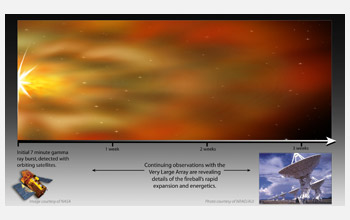Multimedia Gallery
VLA Probes Mysterious Magnetar
Tens of thousands of years ago, an explosive release of energy on the magnetar SGR 1806-20 sent a pulse of gamma rays racing across the cosmos at the speed of light. NASA's brand-new Swift satellite detected the gamma rays as they swept past Earth on Dec. 27, 2004. Then behind them came a steady stream of radio waves from the explosion's expanding fireball--an information-rich signal astronomers using the National Science Foundation's Very Large Array of radio telescopes have been studying ever since.
It was the brightest outburst ever seen coming from an object beyond our own solar system, and its energy overpowered most orbiting telescopes. The burst of gamma rays and X-rays even disturbed the Earth's ionosphere, causing a sudden disruption in some radio communications.
This image accompanied NSF press release, "VLA Probes Secrets of Mysterious Magnetar."
Credit: Nicolle Rager Fuller, National Science Foundation
Images and other media in the National Science Foundation Multimedia Gallery are available for use in print and electronic material by NSF employees, members of the media, university staff, teachers and the general public. All media in the gallery are intended for personal, educational and nonprofit/non-commercial use only.
Images credited to the National Science Foundation, a federal agency, are in the public domain. The images were created by employees of the United States Government as part of their official duties or prepared by contractors as "works for hire" for NSF. You may freely use NSF-credited images and, at your discretion, credit NSF with a "Courtesy: National Science Foundation" notation.
Additional information about general usage can be found in Conditions.
Also Available:
Download the high-resolution JPG version of the image. (306 KB)
Use your mouse to right-click (Mac users may need to Ctrl-click) the link above and choose the option that will save the file or target to your computer.

